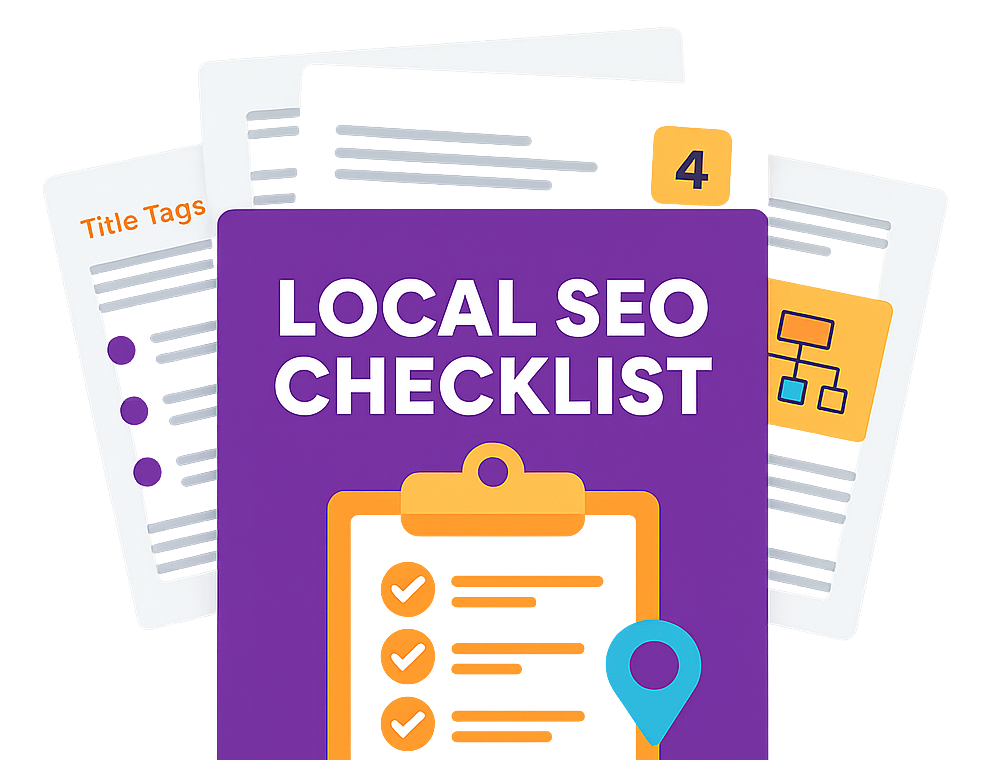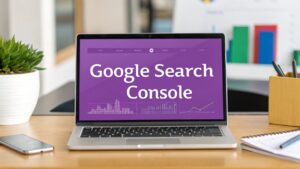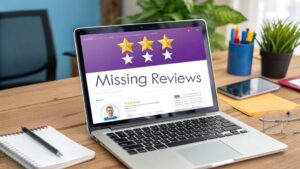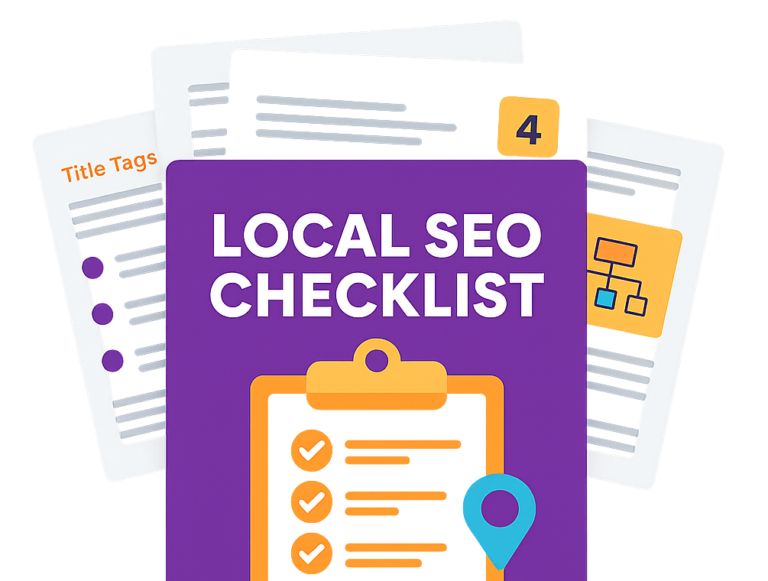Ranking on Google Maps isn’t just about being the closest option anymore. It's a careful blend of a perfectly tuned Google Business Profile, strong local signals, and genuine positive feedback from your customers.
Essentially, you have to prove to Google that your business is the best and most helpful answer for someone searching nearby, not just the one around the corner. To do that, you need to get a firm grip on the three core ideas that shape your visibility.
Understanding Your Google Maps Ranking

Before we jump into specific tactics, let's get the foundation right. Think of Google's local algorithm like a savvy local concierge trying to give a visitor the absolute best recommendation. It doesn't just point to the nearest pub; it weighs up a few key factors to find the most suitable one.
For any UK business, your entire strategy must be built on the three pillars Google constantly evaluates: Proximity, Relevance, and Prominence. Nailing how these three interact is the first real step to climbing above your local competition.
To make this crystal clear, I've broken down exactly what these pillars mean for your business and what you need to do for each one.
Core Google Maps Ranking Pillars Explained
| Pillar | What It Means for Your Business | Key Action |
|---|---|---|
| Proximity | This is the most straightforward factor: how close are you to the person searching? It’s a huge part of the local ranking puzzle. | While you can't move your shop, you can ensure your address and map pin are perfectly accurate everywhere online. |
| Relevance | This is all about how well your business profile matches what the user is looking for. It's about meeting their immediate need. | If someone searches for "emergency plumber Cambridge," your profile must be categorised as a plumber and explicitly mention "emergency services". |
| Prominence | This pillar measures how well-known and respected your business is, both online and in the real world. Think of it as your digital reputation. | Google looks at reviews, local press mentions, and links from other local websites to gauge your authority. |
These three pillars work in tandem, but Prominence is often the secret weapon that separates businesses in a crowded market. If two businesses are just as close and just as relevant, the one with more positive reviews and a stronger online presence almost always wins.
Just being the closest business is no longer a golden ticket. A well-regarded café with dozens of glowing reviews and a detailed profile might easily outrank a competitor that's slightly closer but has a bare-bones profile and zero reviews. Google will always bet on the business that provides a better, more reliable customer experience.
Why Your Google Business Profile Is Everything
Your Google Business Profile (or GBP, as you'll see it called) is the single most important tool you have for this. It's your command centre for local SEO.
Keeping your profile complete, engaging with customers, and building a strong review score is non-negotiable. In fact, your GBP is responsible for roughly 27% of your local ranking power, making it the biggest single factor.
Here’s a stat that really drives it home: businesses that post regular updates to their GBP appear in the top 3 Google Maps results 2.8 times more often than those that don't. If you want to dive deeper, you can discover more insights about Google Maps SEO ranking factors and how they all fit together.
Getting these fundamentals right sets the stage for all the specific, actionable strategies we're about to cover. For any UK business aiming to get into that coveted Google Maps "local pack," mastering these basics is where it all begins.
Mastering Your Google Business Profile
Your Google Business Profile (GBP) is the absolute cornerstone of your Google Maps ranking strategy. Think of it less like a simple listing and more like a dynamic, interactive storefront that clues in both Google and your potential customers about who you are and what you do. A profile that’s been meticulously filled out and is actively managed sends powerful signals of relevance and trust – two things you absolutely need to climb the local search results.
Too many businesses fall into the 'set it and forget it' trap. The reality is, the top-ranking profiles are the ones that are constantly being tweaked and updated. The goal here is to give Google so much accurate, helpful information that it has no choice but to see your business as the best, most authoritative answer for a local search query.
Perfecting Your Core Information
First things first: you need to ensure every bit of your foundational information isn't just complete, but perfectly aligned with how your customers actually search. This is about more than just getting your address right.
Let's start with your business name. It has to be your actual, real-world business name. Tacking on keywords like "Manchester's Best Plumber – Smith's Plumbing" is a classic, amateur mistake. This directly violates Google's guidelines and can land you with penalties or even get your profile suspended. Just keep it clean and accurate.
Your address and phone number need that same level of precision. Always use a local phone number that includes your area code, as this strengthens your ties to the local community. And pay close attention to the small details, like consistently using "Street" versus "St." everywhere your business is mentioned online. This concept, known as NAP consistency, is something we'll dive into more later.
Choosing The Right Categories
Picking your business category is one of the most critical moves you'll make when setting up your GBP. Your primary category has to be a dead-on match for the core of your business. Put yourself in a customer's shoes: what one term would they type into Google to find a business just like yours?
For instance, a café that also happens to sell its own coffee beans should choose 'Café' as its primary category, not 'Coffee Shop', especially if its main business is serving drinks and food on-site. You can always add 'Coffee Shop' or 'Coffee Roasters' as secondary categories to cover all your bases.
Key Takeaway: Be specific and be accurate. While you can add a whole host of secondary categories, your primary category carries the most weight by far. Choosing one that's too broad or slightly off-target will just dilute your relevance for the searches that really matter.
Writing A Compelling Business Description
You get 750 characters for your business description – make them count. This is your chance to sell your business to both Google and actual human customers. Don't just list what you do; tell people what makes you the best choice.
- Front-load the important stuff: Get your key services and location mentioned early on in the description.
- Focus on your unique selling points: Do you offer a cast-iron guarantee, use specific high-quality materials, or have award-winning customer service? Shout about it.
- Keep it natural: Avoid clumsily stuffing keywords where they don't belong. Write for a human first. A well-written, persuasive description that naturally includes relevant terms will always outperform a robotic list of keywords.
Here’s a look at how a completed Google Business Profile appears in search results, showing how all that key information comes together at a glance.
This visual really drives home how your core info, reviews, and photos all work together to create a powerful first impression for anyone looking for your services.
Leveraging Every Available Feature
A complete profile is an optimised profile. Simple as that. Google gives you a ton of features to help you showcase your business, and actually using them signals that you're an active, engaged owner. Making consistent use of these tools is a direct line to improving how you rank in Google Maps.
- Services & Products: Don't just rely on your primary category. You need to detail every single service or product you offer. For each one, take the time to add a proper description and, where it makes sense, a price. This gives Google a rich, granular understanding of exactly what you do.
- Photos & Videos: It's a known fact that businesses with more than 100 photos get way more engagement. Upload high-quality images of your premises (both inside and out), your team, your products, and your work in action. Pro tip: Geotagging your photos before you upload them can provide a subtle but valuable extra location signal.
- Attributes: These are the little details that help customers make a final decision. Are you wheelchair accessible? Do you offer free Wi-Fi? Is your business women-led? Make sure you select every single relevant attribute to help you show up in more specific, filtered searches.
Regularly interacting with your profile is just as crucial as the initial setup. This means posting updates, offers, and events via GBP Posts, and getting on top of questions quickly in the Q&A section. Every action you take demonstrates to Google that your business is active, reliable, and a genuinely valuable part of the local community. To get a much deeper understanding of the entire process, you can explore our detailed guide on Google Business Profile optimisation.
Building Trust with Local Citations

While your Google Business Profile is your digital storefront, Google doesn’t just take your word for it. To truly trust your business, its algorithm acts like a detective, looking for external proof across the web to corroborate your story. This is where local citations and on-page website signals come into play.
Think of every mention of your business on a reputable online directory as a vote of confidence. When these mentions are perfectly consistent, they tell Google that your business is legitimate, established, and located exactly where you claim to be. This trust is a fundamental piece of the puzzle for ranking high in Google Maps.
The Non-Negotiable Rule of NAP Consistency
The entire foundation of a solid citation strategy is NAP consistency. This acronym stands for your business Name, Address, and Phone number. For Google to see your business as a trustworthy entity, these three pieces of information must be identical everywhere they appear online.
Even the smallest slip-up can sow seeds of doubt. A classic UK example is listing "15 High St" on one directory and "15 High Street" on another. It seems trivial, but that tiny difference can be enough to confuse search crawlers and weaken the authority of your citations.
This uniformity is a historically proven ranking factor and the bedrock of local SEO. Inconsistent citations—like having different phone numbers on Yell versus Thomson Local—crush your business's perceived reliability and can directly torpedo your ranking potential. Multi-location companies that get this right often see an average 28% increase in local rankings from a precise citation cleanup alone.
Auditing and Cleaning Your Citation Profile
Before you even think about building new citations, you have to find and fix the old, incorrect ones. This means methodically auditing your existing online presence to make sure every single listing is perfectly aligned.
Your first port of call should be the major UK-based directories and data aggregators. These are the authoritative sources that hundreds of smaller sites pull their information from.
- Core UK Directories: Start with the big names like Yell, Thomson Local, and Scoot.
- Sector-Specific Sites: For a tradesperson, this might be Checkatrade or TrustATrader. For a restaurant, it could be TripAdvisor or a local food blogger's directory.
- Data Aggregators: These are huge databases that feed information to other websites and apps. Getting your data right here creates a massive positive ripple effect.
The audit process can feel a bit manual, but it’s absolutely essential. I always recommend creating a simple spreadsheet to track your NAP information on each platform, noting any inconsistencies that need fixing. This methodical approach ensures you don't miss a single thing that could be holding you back.
Expert Tip: Don't forget about social media profiles like Facebook, LinkedIn, and Instagram. The business information listed in these profiles is also considered a citation and must match your GBP and website perfectly.
Reinforcing Location Signals on Your Website
Your own website is an incredibly powerful tool for reinforcing your geographical relevance. The signals you send from your on-page SEO have to align perfectly with your Google Business Profile and your wider citation profile. When they do, you create a cohesive, trustworthy digital footprint that Google loves.
A simple yet highly effective tactic is to embed a Google Map directly onto your contact page. This isn't just helpful for customers; it's a direct signal to Google that explicitly connects your website to your physical location. When you embed the map, make sure it points to your exact GBP listing.
Furthermore, creating location-specific service pages can massively boost your relevance for searches in surrounding areas. For example, a Cambridge-based plumber shouldn't just have a generic "Plumbing Services" page.
They should create targeted pages like:
- "Emergency Plumber in Cambridge"
- "Boiler Repair in St Ives"
- "Drain Unblocking Services for Huntingdon"
Each of these pages should have unique, helpful content relevant to that specific area, perhaps even mentioning local landmarks or neighbourhoods to strengthen the geographical connection. This strategy shows Google that you're an authority not just at your address, but across the entire region you serve. You can find more practical ways to implement this in our guide to 10 proven local SEO strategies for 2025.
Using Customer Reviews to Boost Prominence
Beyond the technical bits and pieces of your Google Business Profile and the trust you build with citations, your prominence is massively shaped by what real customers say about you. Reviews are some of the most powerful social proof you have, and they speak directly to potential customers and Google’s algorithm. They’re a live measure of your reputation.
A smart approach to your online reputation isn't just about crossing your fingers and hoping for good feedback. It means actively—and ethically—encouraging happy customers to share their stories. Even more, it demands a commitment to engaging with all feedback, turning every review into a chance to show you care.
Why Every Single Review Matters
Google sees each review as a fresh piece of content about your business, written by a real user. A steady flow of positive comments tells the algorithm you’re an active, popular, and well-regarded local business. This consistent activity is a crucial ranking factor known as review velocity.
It’s not enough to hit a high star rating and then coast. A business with 100 five-star reviews from two years ago can easily be outranked by a competitor with 80 slightly less-than-perfect reviews that have trickled in over the last few months. This shows Google your business is relevant right now.
The image below paints a pretty clear picture of the link between a healthy review profile and a top ranking.

The takeaway is simple: a high volume of recent, positive reviews is one of the biggest drivers for landing a top spot in the local pack.
Developing a Proactive Review Strategy
Just waiting for customers to leave reviews on their own is a slow and unpredictable game. If you’re serious about improving your Google Maps rank, you need to build review requests right into your customer process. The trick is to make it incredibly simple for satisfied customers to leave their thoughts.
Here are a few effective ways to do this without breaking any rules:
- Email Follow-ups: A day or two after a purchase or service, send a personalised email. Thank them for their business and ask if they'd be willing to share their experience.
- SMS Requests: For service businesses, a quick text message with a direct link to your Google review page can get a surprisingly high response rate.
- In-Person Prompts: At the end of a great interaction, train your staff to say something natural. If a customer is singing your praises, a simple, "That's brilliant to hear! We’d be so grateful if you could share that on Google," works wonders.
Critical Reminder: Whatever you do, never offer discounts, freebies, or any other incentive for a review. This is a direct violation of Google's policies and can get your reviews wiped or your profile penalised. The goal is to encourage genuine feedback, not buy it.
The Art of Responding to Reviews
Responding to reviews is just as important as getting them in the first place. It shows potential customers that you’re an engaged and attentive owner, and it gives Google yet another positive activity signal. This goes for both glowing praise and sharp criticism.
A thoughtful reply to a positive review makes a customer feel heard and valued. Ditch the generic "Thanks!" and try to personalise it. Something like, "Thank you, Sarah! We’re so glad you enjoyed the new seasonal menu. We look forward to seeing you again soon!" shows you’re paying attention.
Negative reviews can sting, but they’re also a golden opportunity. A calm, professional, and helpful response can completely turn a bad situation around. It shows other readers you take accountability. Always acknowledge their issue, apologise that they had a poor experience, and offer to take the conversation offline to fix it. This public display of customer care often carries more weight than a dozen five-star reviews.
Sometimes, a review is just plain fake or violates Google's policies. When that happens, it's important to know the right steps to take, as we've outlined in our guide on how to remove a bad Google review.
Understanding how to manage both positive and negative feedback is crucial. Let's break down what effective management looks like compared to common missteps.
Effective vs Ineffective Review Management
| Aspect | Effective Approach (Best Practice) | Ineffective Approach (Common Mistake) |
|---|---|---|
| Response Time | Responding to all reviews (positive and negative) within 24-48 hours to show engagement. | Ignoring reviews for weeks or only responding to negative ones. |
| Response Tone | Personalised, professional, and empathetic, even when facing criticism. Addresses specific points. | Using generic, copy-paste replies or getting defensive and argumentative with negative feedback. |
| Negative Reviews | Apologising, taking ownership, and offering an offline solution (e.g., "Please call us at…") | Blaming the customer, making excuses, or publicly debating the details of the complaint. |
| Review Generation | Systematically and politely asking all customers for genuine feedback via email, SMS, or in person. | Offering discounts or free gifts for reviews, which violates Google's policies. |
| Overall Goal | To demonstrate excellent customer service, build trust, and gather valuable feedback for business improvement. | To simply increase the star rating, often at the expense of authenticity and customer relationships. |
Getting review management right reinforces all the other local SEO work you're doing. It’s a powerful signal to both customers and search engines that you’re a trustworthy, active, and reputable local business.
Advanced Strategies for Competitive UK Markets
So, you’ve got your profile fully optimised, your citations are spotless, and you’ve got a steady stream of positive reviews coming in. That puts you miles ahead of most of your local competition. Fantastic.
But let's be realistic. In densely packed UK markets like London, Manchester, or Edinburgh, just nailing the fundamentals might not be enough to get you to the top. When the competition is fierce, the basics only get you in the game. To truly dominate the map pack, you need to pull out the advanced tactics that signal some serious local authority.
This is where you go beyond just managing your own profile and start actively shaping how Google perceives your business within the local community. It’s about building relationships, doing a bit of homework on your rivals, and strategically proving your geographical relevance in ways they probably aren't. This is how you move from just participating to actually leading the pack.
Building Powerful Local Links
Everyone in SEO talks about backlinks, but for Google Maps, the game is a bit different. The focus here is all about quality and local relevance, not just racking up a huge number of links. A single link from a well-respected local organisation is worth far more than a dozen links from generic national directories.
The aim is to earn backlinks that act as a local vote of confidence for your business. Think about who the established, authoritative players are in your community.
- Sponsor a local charity event or a kids' sports team. This almost always gets you a link from their website, which is a brilliant local signal for Google.
- Team up with nearby, non-competing businesses. A florist, for instance, could work with a local wedding venue. A feature on their "recommended suppliers" page with a link is pure gold.
- Get featured in local news or blogs. Did your business win an award or get involved in a community project? Tip off local journalists or bloggers—they're always looking for local stories.
These kinds of links tell Google that your business isn't just in the community; it's an active, trusted part of it. Each one strengthens your connection to the area, giving you a prominence boost that’s really tough for competitors to copy. For a closer look at how all these signals fit together, our guide to local search ranking factors breaks it down even further.
Leveraging Geotagged Media
Every single photo and video you upload to your Google Business Profile is another chance to send a location signal to Google. This is where geotagging comes in. It’s simply the process of adding geographical coordinates to a media file.
When you upload a photo of a job you’ve just finished in a specific neighbourhood, geotagging it first tells Google exactly where that work took place.
Sure, Google is clever enough to infer the location from a photo sometimes, but adding precise geotags leaves nothing to chance. This is particularly useful for service-area businesses like plumbers or electricians who work across different postcodes. A portfolio of geotagged images from jobs in Cambridge, Ely, and Huntingdon provides hard evidence of your service area.
Expert Tip: Don't stop at your Google Business Profile. Apply the same geotagging technique to the images you upload to your website, especially on your location-specific service pages. This creates a powerful, consistent geographical message across all of your online properties.
Conducting Competitor Analysis
If you want to beat the competition, you first need to understand what they're doing. A little digital detective work on Google Maps can quickly reveal their weaknesses and show you where the opportunities are.
Start by searching for your main keywords and taking a close look at the top three businesses in the map pack. Look for patterns in their:
- Primary and Secondary Categories: Are they using a category you’ve missed that might be bringing them business?
- Review Velocity and Responses: How many reviews are they getting each month? Are they responding, and how quickly? A slow response is an open goal for you.
- GBP Posts and Q&A: Are they actively using Posts to promote offers? Have they taken the time to answer common customer questions in the Q&A section?
By methodically analysing what the top players are doing, you can spot the gaps. Perhaps they're slow to reply to reviews, or maybe they haven't posted an update in months. These are your chances to shine by offering a better, more engaged customer experience. This analysis gives you a clear roadmap for your own efforts, helping you focus on the actions that will actually make a difference.
Common Google Maps Ranking Questions

Even with a solid strategy in hand, I find that most UK businesses still have questions about the nuts and bolts of getting seen on Google Maps. The path to the local pack can feel a bit murky, so let's clear up some of the most common queries we get.
Getting these fundamentals straight helps set realistic expectations and lets you focus your energy on what actually moves the needle.
How Long Does It Take to See Results?
This is the million-pound question, isn't it? The honest answer is: it depends. Your starting point and how competitive your local market is will play a huge role.
If you’re consistent with optimising your Google Business Profile and building out local citations, you could see some positive movement within a few weeks. But for those big, lasting improvements that push you into the coveted top three, you’re realistically looking at 3 to 6 months.
Think of it this way: Google needs time to crawl, index, and—most importantly—trust the new signals you're sending. Patience and consistency are your best allies here.
Can I Rank in a Town Where I Have No Address?
Trying to rank in a town where you don’t have a physical, verified address is an uphill battle. It’s extremely challenging. Google Maps is fundamentally built on proximity, so for those all-important "near me" searches, a business with a real local presence will almost always win.
Service Area Businesses can set a wider catchment area, but their ranking power is still anchored to their verified address. A word of warning: using virtual offices or mailboxes to fake a location is a direct violation of Google's guidelines. It's a fast-track ticket to getting your entire profile suspended.
A much better approach is to create location-specific pages on your website. This helps you rank in the traditional organic search results for those surrounding towns, which is a far more sustainable strategy.
Will Negative Reviews Hurt My Ranking?
A single bad review won't tank your ranking. But a consistent pattern of poor feedback? That definitely can. Google's algorithm uses review sentiment and your overall star rating as a direct signal of your business's quality and prominence in the community.
A consistently low star rating can absolutely damage your ability to rank. The key isn't to avoid negative reviews entirely—that's impossible—but to respond to them professionally. This shows prospective customers and Google that you're an engaged and accountable business owner.
Your primary goal should be to keep a steady stream of new, positive reviews coming in. This maintains a high overall rating and demonstrates ongoing customer satisfaction.
Is It Worth Paying a Company for Google Maps SEO?
For many busy UK businesses, the answer is a resounding yes. While you can absolutely follow the steps in this guide yourself, the day-to-day grind of citation building, competitor analysis, review management, and continuous optimisation is incredibly time-consuming.
A reputable local SEO agency brings expertise and specialised tools to the table, which means they can get the job done far more efficiently. They live and breathe Google's constant algorithm updates and can often deliver faster, more substantial results, freeing you up to do what you do best: run your business.
At Bare Digital, we specialise in creating bespoke SEO strategies that help Cambridgeshire businesses dominate their local search results. We combine technical expertise with a deep understanding of the local market to deliver measurable growth. Get your free, no-obligation SEO Health Check today and discover how we can elevate your Google Maps presence.








